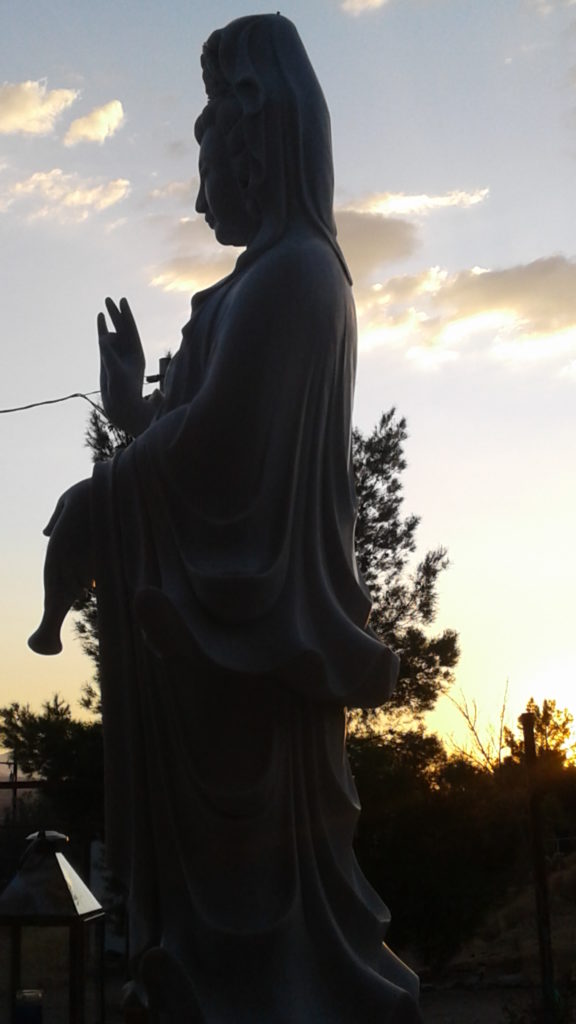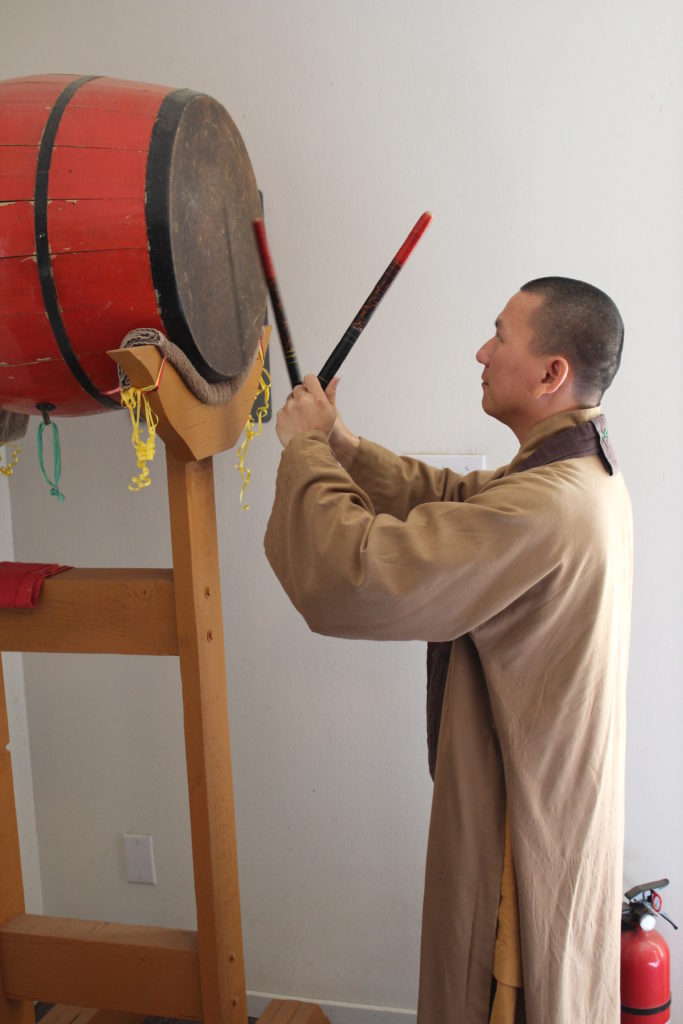Upcoming Three-day Memorial Retreat – November 1-3, 2024
The Monks of Chua Thien An Temple announce a 3-day silent meditation retreat to commemorate 100 days since the passing of our Master and Teacher Most Venerable Thich An Giao, Roshi. This retreat will start at 9:30 pm on Friday, November 1 and will end after a final Memorial Service in our Dharma Hall on Sunday, November 3, 2024 at 11 am. Please contact Thich Tam Pho Minh (949) 300-4033 to attend, so that food and accommodations can be provided. There is no charge to attend, but donations are gladly accepted.
Notice: The Monks of Chua Thien An at the Desert Zen Center would like everyone to know that no one has been appointed as the Abbot. Updates will be posted here.
Sharing the Buddhadharma for over 40 years
Chùa Thiên Ân Monks

from left clockwise: Thich Tam Mung, Thich Tam Pho Minh, Thich Tam Vui Mung, Thich Tam Dat, Thich Tam Tri
Center: Roshi An Giao
Services at DZC
Zen Basics
The foundational teachings of Buddhism: The Four Noble Truths and the Eightfold Path are explained below.
Training Retreats
Also called Sesshins, these Zazen retreats are focused on seated and walking meditation practice in the Zendo. Participants may have a private conversation with the Roshi (Dokusan). Please RSVP for all retreats.
Ceremonies
Please contact us for support and assistance with marriages, blessings of children, dedications, funerals and memorial services.
Thursday Evening Meditation
In the Zendo starting at 7pm.
Followed by tea and conversation.
Dharma Class
Sunday 9:30 AM – 10:30 AM
Special Events
The annual calendar of events and celebrations at the DZC includes: Vu Lan , Buddha’s Birthday, Temple Days, Reaffirming the Precepts, Bodhi Day and the Rains Season Retreats.
Reaffirming the Precepts
This important Buddhist ceremony takes place the last Sunday of every month at 11 am
Online Videos
Video of Roshi’s dharma talks (a sermon or public discourse on Buddhism) are archived on the DZC’s YouTube channel, and can be viewed at the bottom of this page. Also, Sunday services and dharma talks are live streamed on our Facebook page.
Sunday Services
In the Dharma Hall
from 11:00 AM to 1:00 PM.
Followed by tea and discussion.

About the Desert Zen Center
The center was purchased in 1976 and was used for monthly meditation retreats by the members of the Long Beach Zen Monastery and the International Buddhist Meditation Center.
In 1982, the Venerable Thich An Giao and his Senior Disciple, Thich Tam Hien moved to the desert to take up permanent residence at the Center. At that time the temple was named Monjuji. Since then, a number of buildings have been erected, a number of monks trained and the service to the local community expanded.
At the first Grand Ordination at our temple, held in December of 1999, the Temple was renamed Chua Thien An in remembrance of the Most Venerable Thich Thien An, Roshi’s Vietnamese Master.
The Four Noble Truths and the Eightfold Path
THE FOUR NOBLE TRUTHS

The First Noble Truth
Suffering – Birth is suffering, aging is suffering, death is suffering, sorrow, lamentation, pain, sadness, and distress are suffering. Being attached to the unloved is suffering, being separated from the loved is suffering, not getting what one wants is suffering. In short the five aggregates of grasping are suffering.

The Second Noble Truth
The Origin of Suffering – Craving gives rise to rebirth, bound up with pleasure and lust, finding fresh delight now here and now there, that is to say sensual craving, craving for existence, and craving for non-existence.

The Third Noble Truth
The Cessation of Suffering – It is the complete fading-away and extinction of this craving, the forsaking and abandonment of it, the liberation and detachment from it.

The Fourth Noble Truth
The Way of practice leading to the Cessation of Suffering – It is just this, the Noble Eightfold Path: Right View, Right Thought, Right Speech, Right Action, Right Livelihood, Right Effort, Right Mindfulness, and Right Concentration.
THE EIGHTFOLD PATH
In each case below the first word used is “right”. The sanskrit word this based on is either “samyak” or “samyag”. This is normally translated as “right” but has a meaning of complete or wholesome. These words are also sometimes translated either as “correct” or “perfect”.

Right View
Seeing things as they are.

Right Thought – Aspiration, Motive, Resolve
Renunciation, Non-ill will, Harmlessness

Right Speech
Refraining from lying, gossip, slander, harsh speech, and frivolous speech.


Right Action
Refraining from taking life, taking what is not freely given, and sexual misconduct. Avoiding actions that conflict with moral discipline.

Right Livelihood
Not engaging in a livelihood that harms other sentient beings.

Right Mindfulness
Contemplation of the body as body, feelings as feelings, mind as mind, and mind objects as mind objects. Clearly aware having put aside hankering and fretting for the world.

Right Effort
A practitioner rouses the will, makes an effort, stirs up energy, exerts the mind and strives to prevent the arising of un-arisen evil and unwholesome mental states, overcome those that have arisen, and produce un-arisen wholesome mental states. (Cultivation of what is Karmically wholesome.)

Right Concentration
Here a practitioner, detached from sense-desires, detached from unwholesome mental states, enters and remain in the first jhana, which is thinking and pondering, born of detachment, filled with delight and joy. And with the subsiding of thinking and pondering, by gaining inner tranquility and oneness of mind, he enters and remains in the second jhana, which is without thinking a pondering, born of concentration, filled with delight and joy. And with the fading away of delight, remaining imperturbable, mindful and clearly aware, the practitioner experiences the joy of which the Nobles Ones say: ” Happy is the person who dwells with equanimity and mindfulness”, he enters the third jhana. And, having given up pleasure and pain, and enters and remains in the fourth jhana, which is beyond pleasure and pain, and purified by equanimity and mindfulness.
Roshi An Giao Dharma Talks
Video of Roshi An Giao’s dharma talks (a sermon or public discourse on Buddhism.)
Stay Tuned and Watch our Dharma Talks
Visit DZC
- 10989 Buena Vista Rd, Lucerne Valley, CA 92356
- roshiangiao@outlook.com
- 760-985-4567
Directions | Instructions
